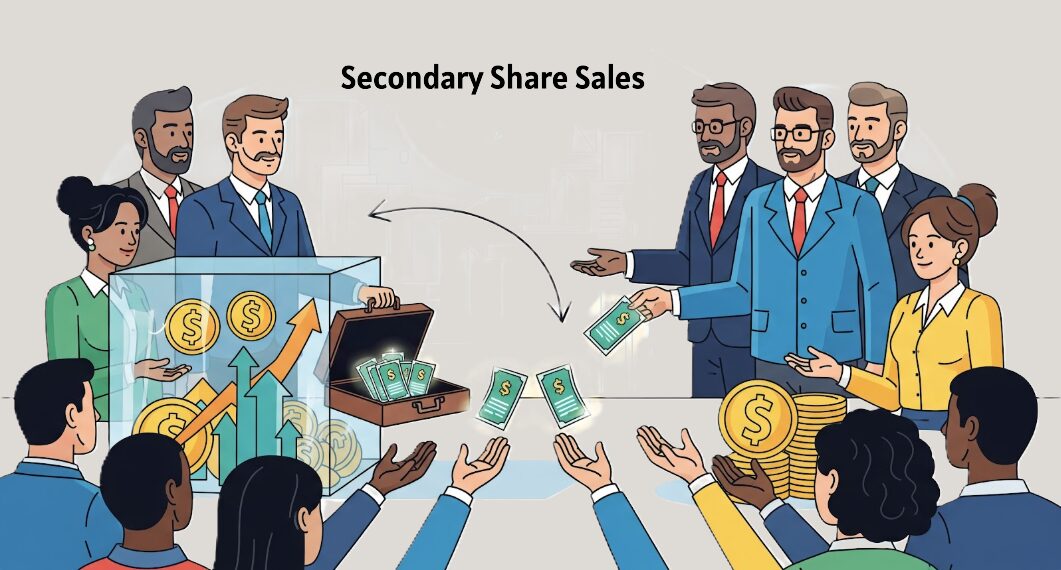Secondary share sales are quickly garnering interest among founders in recent times. Also called secondary transactions or simply secondaries, this strategy enables them to get some liquidity during the building stages.
Startup growth trajectories often take years before culminating in an acquisition or IPO. Founders may have to wait at least 10 years before seeing any real returns. All this time, they are committing personal time and finances, not to mention carrying exceptional risk.
By organizing a secondary share sale timed around a new fundraising round, you can earn some financial rewards. The most significant advantage of executing this strategy is that it doesn’t mean you’re exiting the company. You’ll only recover some amount of liquidity for personal responsibilities.
Then again, many founders choose this route to access capital to invest in another venture they want to run side-by-side. Employees who own option pools also use the secondary share sales approach to convert their paper holdings into cash.
Read ahead to understand in detail what secondary transactions are. Also, learn how to leverage such share sales to de-risk some of the bootstrapped capital you’ve invested in the startup.

*FREE DOWNLOAD*
The Ultimate Guide To Pitch Decks
Understanding What Secondary Share Sales Are
During secondary share transactions, the existing shareholders of a private company sell some of their shares. These shareholders include the founders, employees with option pools, and early, lead, or seed-stage investors. They may sell their holdings to new or existing shareholders in the company.
Secondary sales don’t involve creating new shares, as in a primary funding round. As a result, no new capital enters the company, so its capitalization table remains intact. The transaction simply enables the shareholders to transfer some of their ownership stake.
The proceeds from the sale don’t go into the company, but the selling shareholder retains the money. Understand that a secondary transaction is different from a “primary sale,” where the company issues new shares to the investors.
During a primary sale, the proceeds are diverted solely to the company. That is what venture capital investing is all about—when investors finance companies during seed, Series A, B, or C rounds.
In both primary and secondary share sales, investors purchase company stock. The key difference is in who retains the proceeds from the sales.
In short, if the proceeds are used to scale the company and new shares are issued, that’s a primary sale. However, if the shareholder retains the proceeds and no new shares are issued, that’s a secondary sale.
It is crucial to underscore that a secondary share transaction does not indicate that the company will not go to IPO anytime soon.
On the contrary, a secondary could mean that the founders are preparing for an acquisition at a substantial valuation. Or, for making its debut on the stock exchange. Under both circumstances, shareholders stand to earn rich returns.

Raise Capital Smarter, Not Harder
- AI Investor Matching: Get instantly connected with the right investors
- Pitch & Financial Model Tools: Sharpen your story with battle-tested frameworks
- Proven Results: Founders are closing 3× faster using StartupFundraising.com
When do Secondary Transactions Occur?
Secondary transactions typically occur when a startup has achieved significant traction and shows impressive metrics. This startup dominates its space, with substantial market share and a large customer base. Investors can see that it has the potential for a major, high-value acquisition or IPO.
At this stage, the founders, business partners, early investors, and employees may offer third parties a chance to purchase stock. The shareholders may want to use the money to scale the company or divert it toward other pursuits. In return, they sell a percentage of their ownership stake for cash.
Most secondary share sales happen when the company is in its later stages and is well established. Since it is performing well, secondary transactions can involve millions or even tens of millions of dollars. Early investors often leverage this option to recoup some of the value they helped create.
Secondaries occur only when the company is a private entity. Once it goes public, its shares are available for purchase or sale on major stock exchanges (e.g., NASDAQ, NYSE). However, secondary sales are also subject to the U.S. Securities and Exchange Commission (SEC).
SEC Rule 144 has laid down the framework for secondary transactions, including who can buy the shares. The apex organization also dictates the number of shareholders the company can have. And the duration for which private shareholders must retain their holdings, among other regulations.
Why Secondary Share Sales are Gaining Ground
More founders and investors are now becoming interested in secondary transactions in recent times. Several reasons have contributed to this phenomenon. Here are some of them.
Startups Stay Private Longer
Increasingly, more startups are choosing to remain private for longer rather than issue an initial public offering (IPO). Founders prefer to delay going public until the company has reached a later growth stage and is more stable. And, this can take up to 10 years or more.
Before the 2008 crash, companies would go public at lower valuations or even if their revenues were low. The objective was to enable investors and early employees to cash out during the IPO.
However, present-day companies remain private even though they’re operating well and generating substantial revenue. As a result, investors or employees are unable to get liquidity for the shares they own. This is why a secondary transaction is a better option.
Investors Want In on Top-Performing Companies
The startup landscape has noted yet another interesting phenomenon in the last few years. Many private companies prefer to roll back their revenues into operations, which lowers the need to raise external capital. Some have successfully earned the unicorn status with over $100M in revenue.
Earlier, investors offered to back companies during their Series A and B rounds and later Series C and D rounds. Now they need to rethink their strategies, as no one really needs to raise capital. Some excellent examples include Pinterest, Twitter, Palantir, Facebook, and Uber.
The only strategy venture capitalists (VCs) and private equity firms can use to participate in returns is secondary transactions. Ultimately, these deals are about getting early access to scarce stocks due to limited availability.
Startups simply don’t need financing, nor are they interested in diluting their ownership stakes. The possibility of control issues is also eliminated. Statistics indicate that the number of tech IPOs has risen significantly in the past decade. Similarly, secondary share sales have also grown.
Investors are eager to buy pre-IPO stock in high-performance companies in anticipation of rich returns. Further, high revenues and accelerated growth typically indicate that the company will go public within the next couple of years. That is, instead of the typical 5 to 7-year time frame. This factor lowers the associated risk, making the investment a safer bet.
Liquidity for Employees and Early Investors
Early employees and members of the founding team don’t always remain with companies for 10 years or more. That is, until the companies go public and can cash in their option pools. The chances of them moving ahead in their career trajectories are much higher.
When that happens, employees are eager to cash in their holdings upon leaving the company. This is the reward they get for working in an early-stage startup.
Particularly if the stock was part compensation in lieu of a lower-than-market-rate salary, thus, secondary share sales allow them to obtain the liquidity rightfully theirs.
From the investors’ perspective, selling a small stake in a well-performing company can bring them substantial liquidity. This is their reward for backing a pre-seed company and believing in the founders.
Maintaining their holdings until the company goes to IPO is always an option. But that move may not align with the fund’s investment horizon.
Founders are also in similar situations. They can use the money to purchase personal assets or keep up with family obligations. Thus, selling a limited number of shares can help them get ahead in life, rather than waiting for IPOs. Of course, the risk of the startup failing is also very real.
Diversifying the Investor Pool
Company founders sometimes offer secondary stock to the strategic investors they want to bring on board. This approach enables them to diversify their investor base in their cap table, particularly if the new entrants bring exceptional value to the company.
This value can be in terms of non-financial assets, such as networking opportunities and expertise. Offering them secondary stock is a great incentive to back the company.
Keep in mind that storytelling is everything in fundraising. In this regard, for a winning pitch deck to help you here, take a look at the template created by Peter Thiel, Silicon Valley legend (see it here), which I recently covered. Thiel was the first angel investor in Facebook with a $500K check that turned into more than $1 billion in cash.
Remember to unlock the pitch deck template that founders worldwide are using to raise millions below.
Opportunity for Customers to Back Their Favorite Brand
When companies offer secondary share sales to third parties, top customers can also approach them for strategic purchases.
If the brand is well-established and popular among customers, they may welcome the opportunity to purchase a stake in it. In this way, they can participate in its future success.
Typical Buyers of Secondary Stock
If you’ve made the decision to liquidate your ownership stake with secondary share sales, you’ll list potential targets. These are the entities that could be interested in participating in the transaction. Here are some of the entities you’ll approach:
Institutional Investors – Existing and New
Institutional or accredited investors should be your top priority. You can approach those who have already invested in your company and are familiar with its performance and operations. Alternatively, you can reach out to new investors looking for viable opportunities.
Existing investors who are keen to own a specific percentage threshold in the company may be open to a combination. That is, a blend of primary and secondary shares to maintain, say, a 20% stake in the company.
For instance, an investor owns a 14% stake in a company in preferred stock. Given the opportunity, they could be interested in participating in secondary share sales to bring that percentage up to 20%. New investors anticipating a sharp increase in share value could also approach the founders.
Sometimes funding rounds are oversubscribed, and investors eager to get in may have lost out to other applicants. A secondary is a great alternative that enables them to own viable stock.
Secondary-Specific Funds
In the last few years, several funds have emerged geared specifically toward secondary purchases. Some examples include Coller Capital, Blackstone Strategic Partners, HarbourVest Partners, and Lexington Partners.
Further, several top VC firms have also set up arms that invest only in secondary share sales of promising companies. These firms have allocated a portion of their capital solely to these investments.
Investment Banks
Approaching investment banks is also an option for secondary share sales; however, be mindful of their applicable fees. Since investment banks have a broad client base of investors, they are well-positioned to assist with transactions.
These entities can not only connect you with investors, but also negotiate and facilitate the deal. However, before accepting an offer, make sure to vet the buyers carefully. Both internal and external investors will want to purchase shares in the company.
You’ll want to restrict the percentage stake a single investor can own to protect your company from unexpected hostile takeovers. Also, run background checks on the investment banks before partnering with them.
Organizations Running “Matching” Websites
Several organizations run websites like the Second Market, Shares Post, and Micro Ventures. Their objective is to “match” or introduce buyers and sellers of secondary share sales. The websites can be curated or non-curated.
- On curated sites, organizers select shares that investors are likely to be interested in. Next, they package the shares and offer them to investors. This strategy works best for high-performance companies with a good reputation. Typically, the sites target investors or entities that invest small amounts of capital and combine them into a single pool.
- On non-curated sites, the organizers list companies offering secondary share sales. If enough investors express interest in a company, the site managers form a Limited Liability Company (LLC) to purchase the shares.
In Conclusion
Although many company founders are leveraging secondary share sales to get some liquidity before an IPO or acquisition, be cautious. Before you offer up some of your stock, make sure to understand the terms and conditions of the sale.
It is also advisable to consult an attorney well-versed in company law who can advise you on SEC rules. Most importantly, retain a fundraising advisor to evaluate the long-term impact and potential dilution. Particularly if you raise a future funding round or enter into a merger or acquisition deal.
You may also find our free library of business templates interesting. There, you will find every single template you need to build and scale your business completely, all for free. See it here.





Facebook Comments